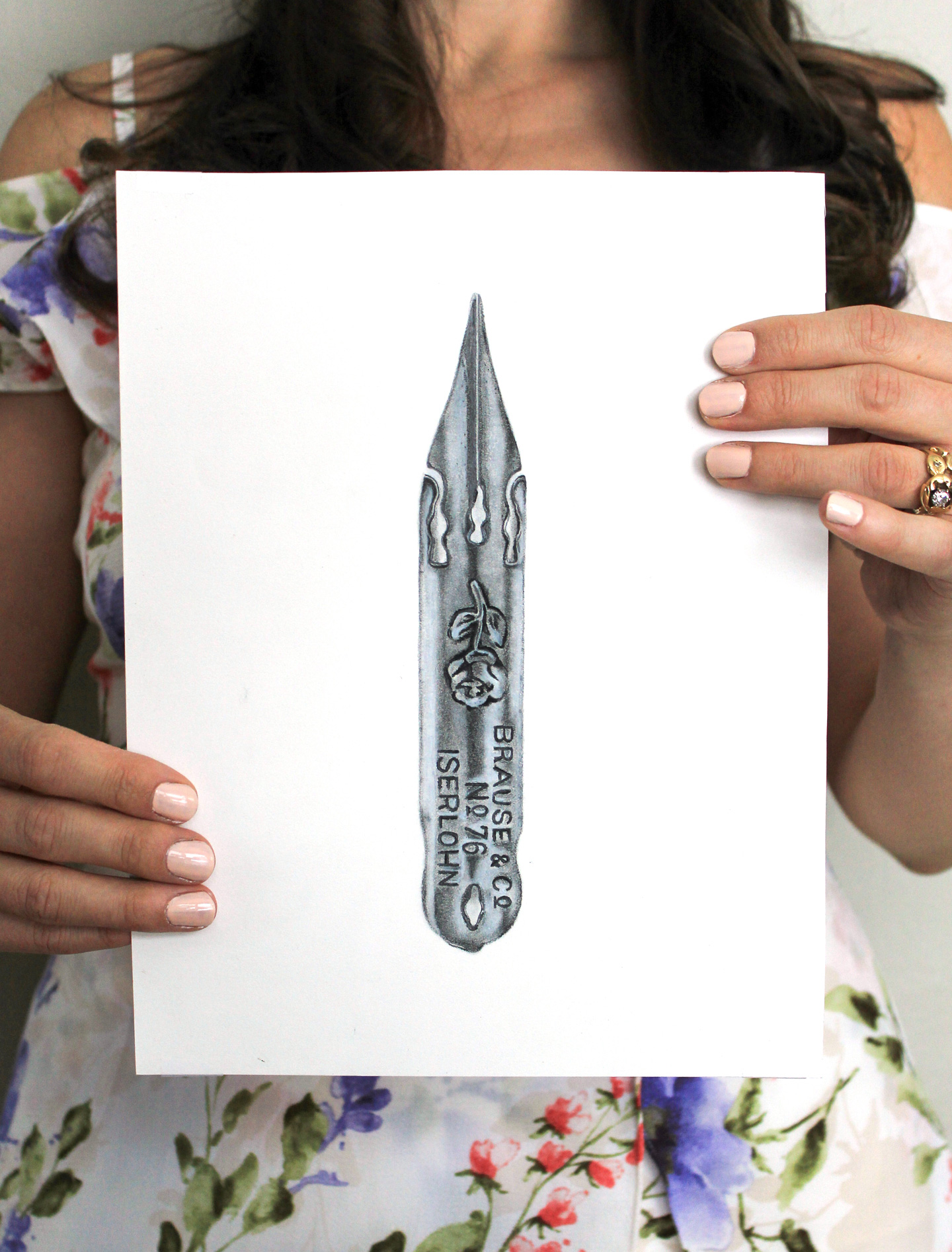
Every week or so, I provide a little mail art tutorial on the TPK Facebook page. In today’s blog post, I thought it might be neat to consolidate four of the Facebook mini-tutorials so you can have them all in one place, Pinterest-friendly and ready to inspire! In order to give you a variety, I have included two simple concepts, and two rather involved concepts. There’s something in this post for everyone!
1. Decoupage Mail Art

As long as you have access to a piece of paper (newspaper, printout, magazine) with an interesting element printed on it, you can create this project! First, you’ll want to find and cut out the thing you want to decoupage on your envelope. I was delighted to discover a ~2″ (50 mm) x ~3″ (76 mm) painting of a dignified-looking gentleman in the September 1956 issue of American Artist!

Set your cutout aside, then use the envelope template included in the Amazing Envelopes for a Latté package to draw pencil guidelines for calligraphy.
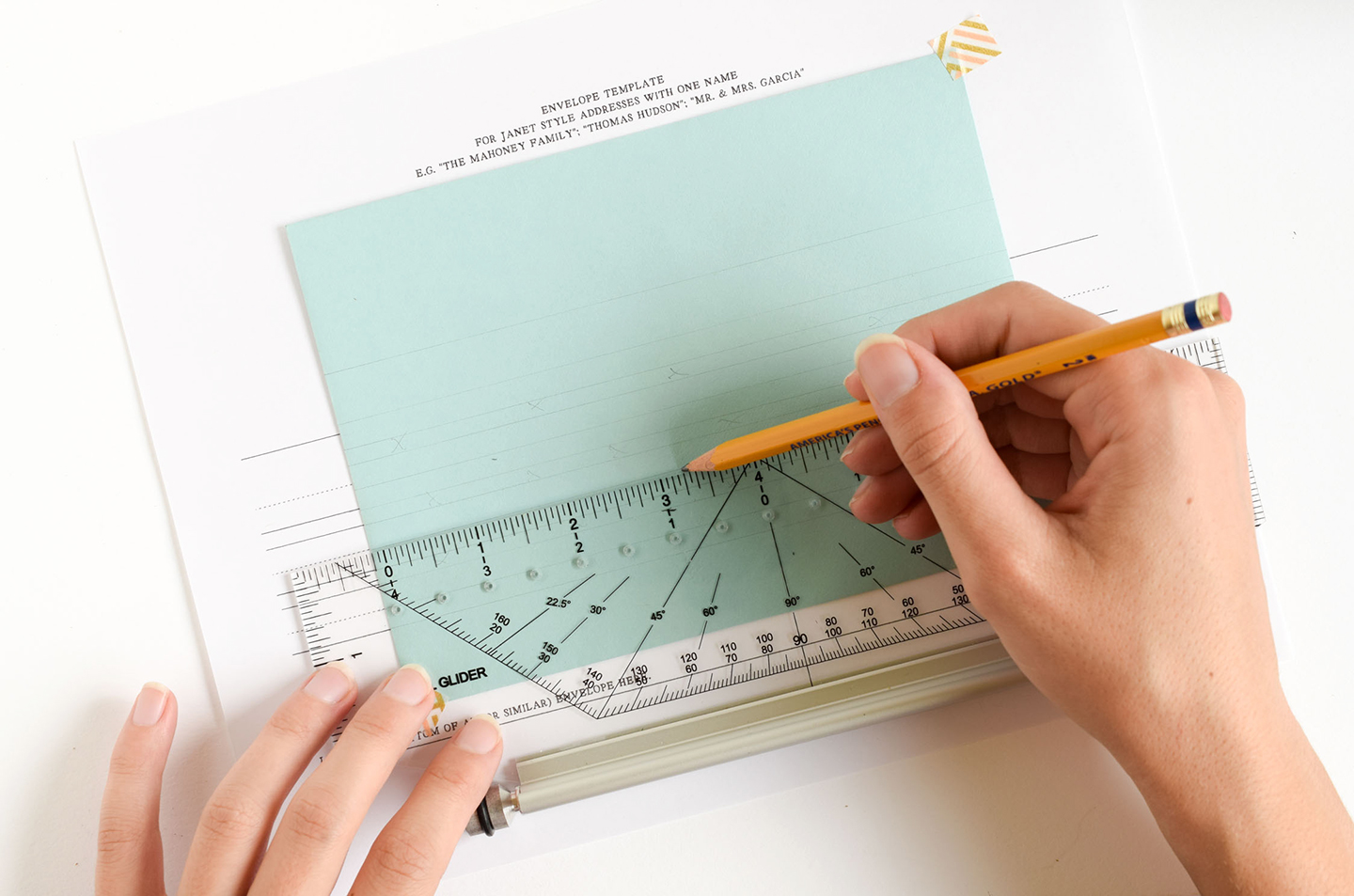
Figure out how much space your cutout will require on the left, then draw a vertical line in pencil where that space requirement ends. You can then use that vertical line as a guideline for a left-justified address! I am writing my recipient’s name in Janet Style calligraphy in the photo below.
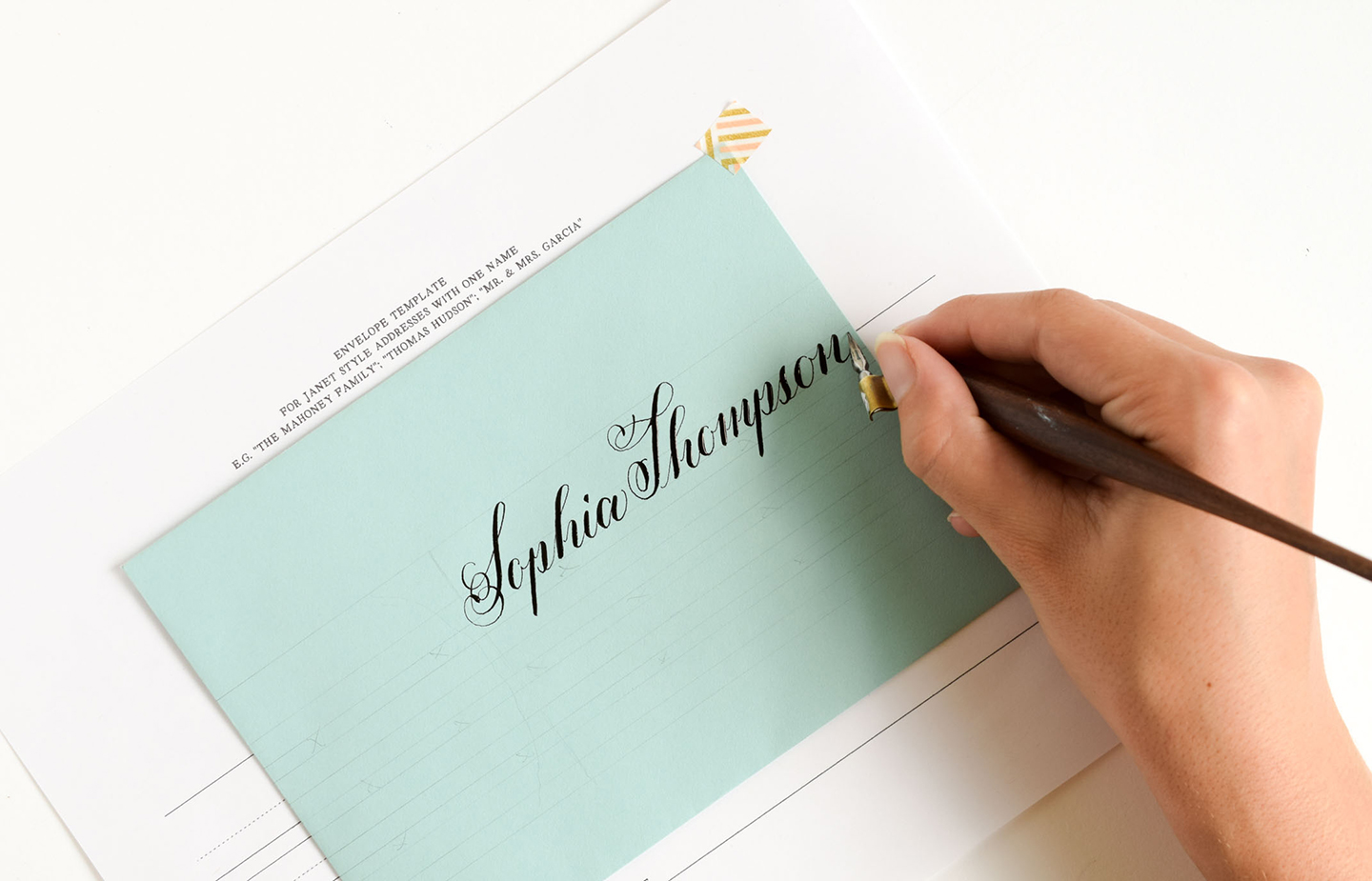
Once you have calligraphed the address, glue down your cutout. You can add little embellishments around the cutout if you’d like to give it a little more “oomph”, but that’s optional! (I used the Finetec Golds palette to add some flair.) At this point, the envelope is finished!

The decoupage mail art concept is very straightforward and versatile; it’s a wonderful go-to if you are short on time! I love decoupaging on colored envelopes and using unconventional colors of ink to make the piece stand out.
2. Hanging Planters Mail Art

This mail art shines because of its unconventional layout and funky-cool planter illustrations! To make it, you’ll start by painting five assorted shapes to represent pots; these shapes should be positioned at at different positions on the envelope. The shapes I chose to draw are shown below, so you can emulate mine or choose other shapes (e.g. squares, rectangles). Notice that on the middle planter, I left some room for leaves to overlap the pot!

Use a fine-tipped paintbrush to draw in all different sorts of leaves in varying shades of green. If you’re having trouble coming up with different leaf shapes, try running a Google Image Search for “house plants”.
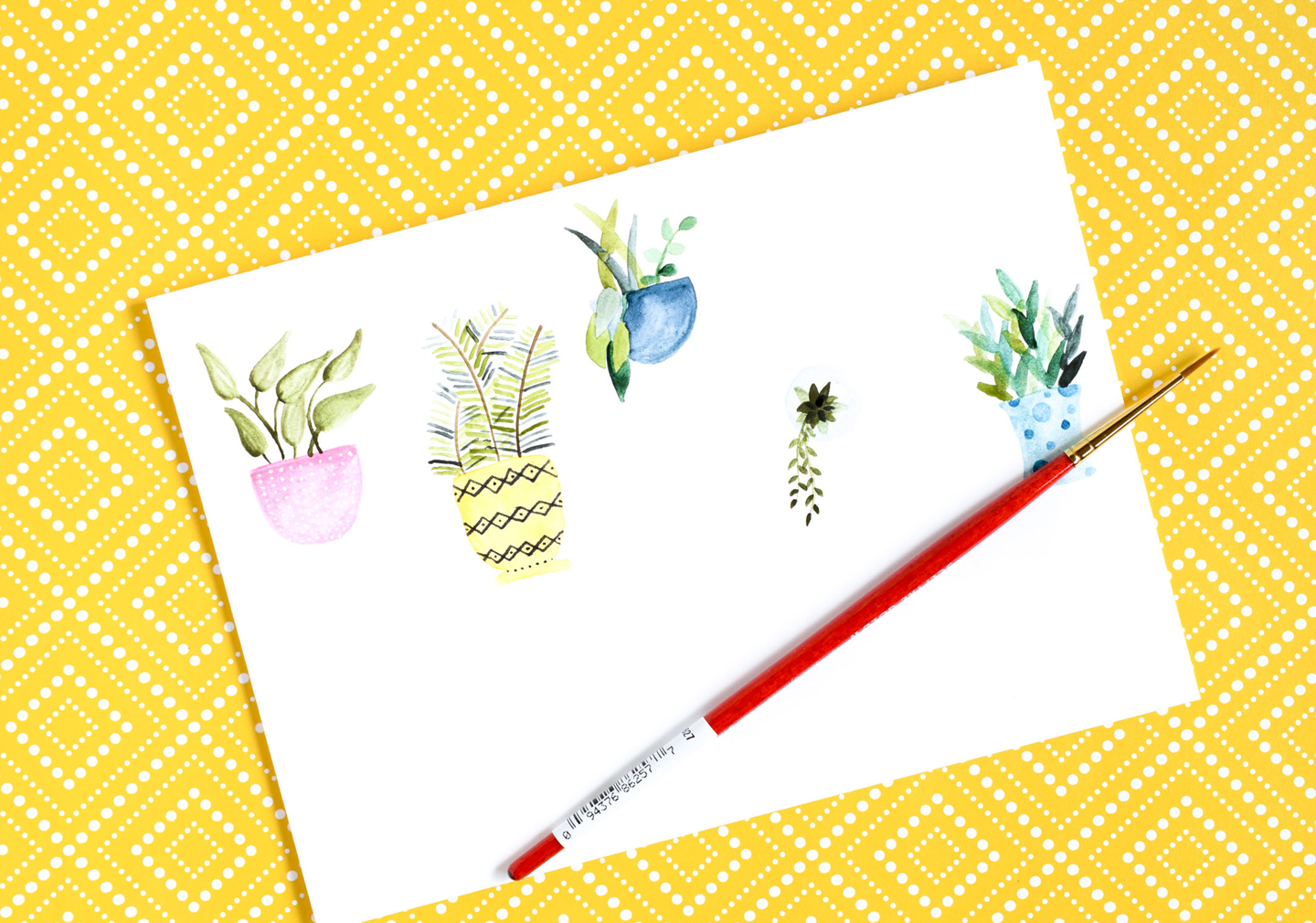
Once the paint used for the leaves has dried, load your nib with watercolor paint using the watercolor calligraphy technique. First, draw little hooks centered above each plant; each hook should be coming from the top edge of the envelope. Next, draw strings/rope to hold the plants up! If you take a look at the photo below, you’ll notice that I showed each planter having a different string configuration. For example, the pink planter has strings that loop under the planter with beads. The blue planter in the center has simple strings that are attached to the edge of the planter. Feel free to follow suit with your own string placement variation!
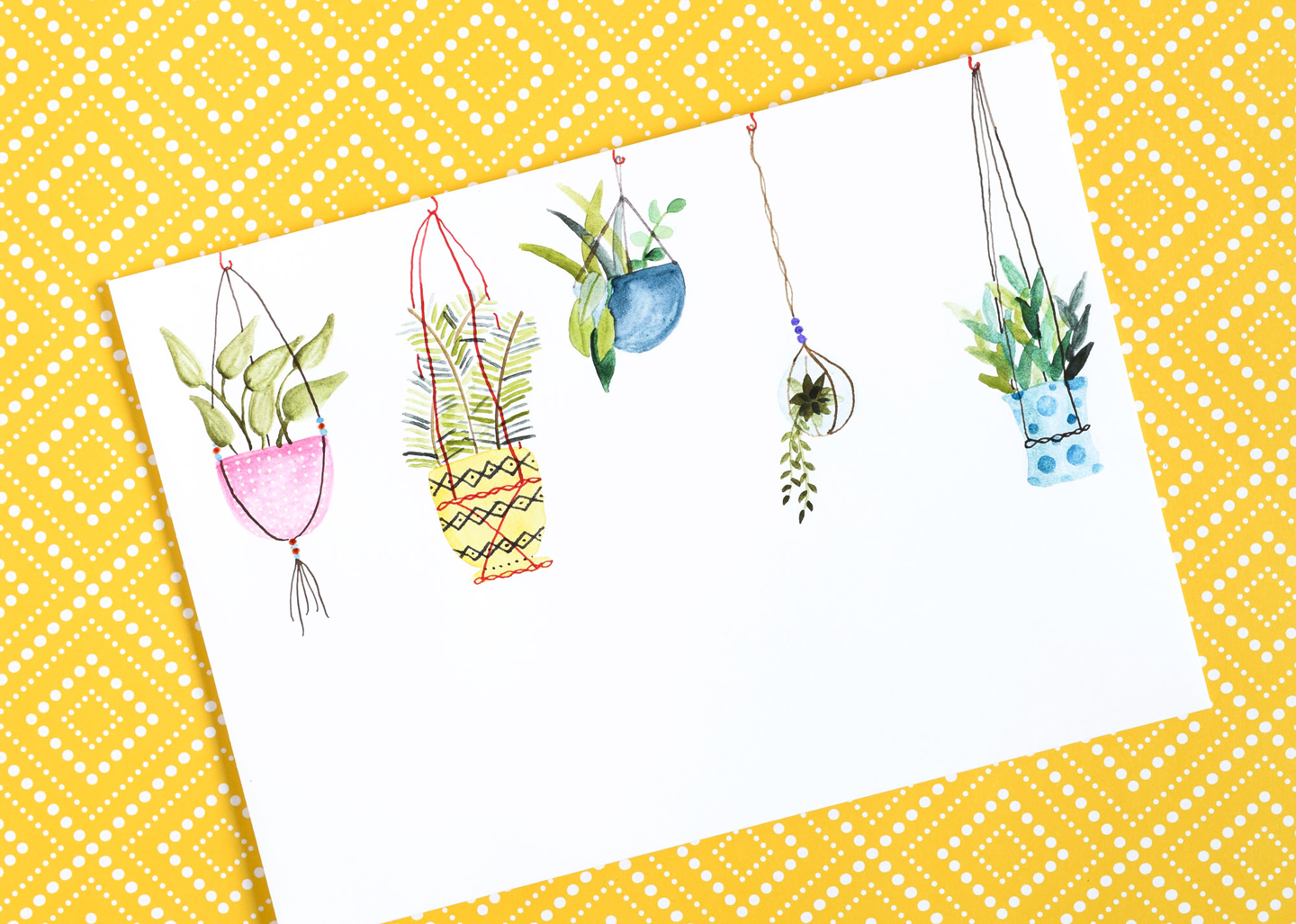
Once you have drawn the planters, write the recipient’s address. I used Kaitlin Style calligraphy, and I justified my address to the right, but of course the calligraphy style/orientation you use is up to you! Kaitlin Style is very loose and free, so it adds that much more of a casual air to the envelope. If you want to write calligraphy that adds a bit of formality, Janet Style or Flourish Formal would do the trick!

I love the simplicity behind this illustrated mail art concept; hanging planters make for such a sweet and serene piece! If you like the planters, you can also experiment with featuring them on non mail-art projects — for example: gift tags and bookmarks. They make anything look fantastic!
3. Stag Watercolor Mail Art
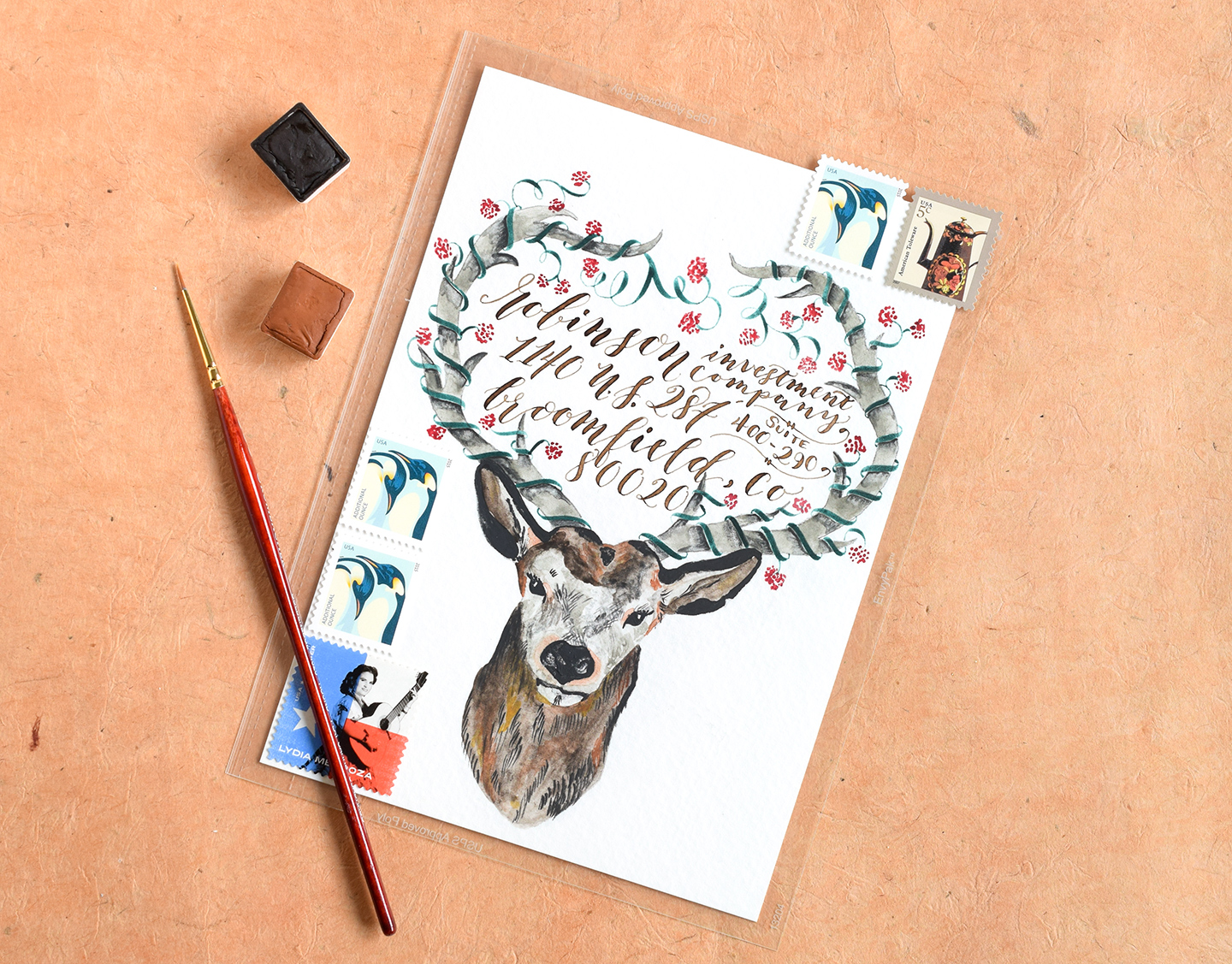
In order to create this stag mail art, you’ll need a clear envelope and a piece of watercolor paper that has been cut to fit that clear envelope! I purchase my clear envelopes from envelopes.com; if you live outside the US, you will more than likely find them on Amazon. Once you have cut your paper to a size that is perfect for your envelope, use a pencil to draw an outline of a stag. If you’re like me, you probably don’t have a super-vivid mental picture of a stag, so you’ll need to Google Image Search “stag”, and find an image that you can reference. (At this time, I can’t find the exact image I used — but it looked like this one.) Once your outline is drawn, write your address in the middle of the horns; I have used walnut ink and Kaitlin Style calligraphy here.

After you have written the address, use the watercolor calligraphy technique to load green paint onto your dip pen. Use your dip pen to draw vines spiraling around the antlers, then use a paint brush and red watercolor to draw little clusters of dots on and around the vines to represent flowers.

When the paint used to make the vines and flowers has dried, use shades of gray and black watercolor to fill in the antlers. In the photo below, you’ll notice that I have painted shadows under every vine. That’s optional, but certainly something you can do to make your piece more realistic! When the horns are finished, start painting the face.
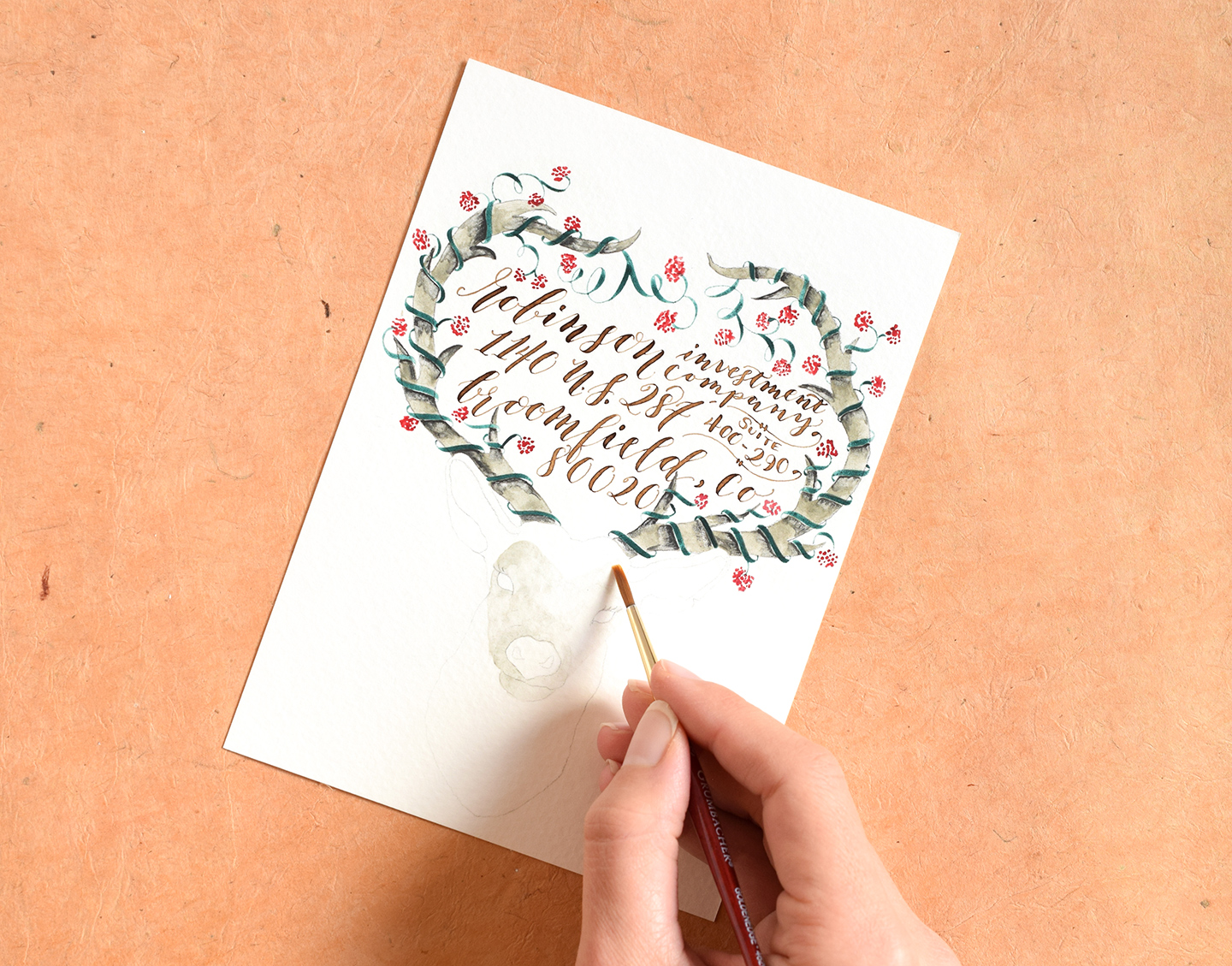
Use a variety of different earth-toned watercolors (I use Greenleaf & Blueberry) to fill in the face. Basically, what I do is reference the photo of the stag that I used to draw the outline, and I try to identify (and use) all the different colors I see in the stag. My stag’s fur had tones of orange-red, yellow, and dark brown; then he had plenty of features that were black. Painting something like this does require a bit of knowledge about shading/watercolor painting, so if you’re curious to learn some techniques, you might check out Painting with Watercolors for Beginners and Painting with Watercolors for Beginners Part II.

Once the watercolor paint has dried, you can slip your stag illustration into the plastic envelope! Remember to add extra postage (as per the How to Make Deliverable Mail Art post)! Clear envelopes are non-machinable and have to be handled by a postal employee, which always incurs extra postage. The unconventional orientation of the address (vertical rather than horizontal) also renders this piece non-machinable!

Please feel free to modify the stag concept to suit you! If you’re not a bit fan of watercolor painting, you could always do an ink drawing, or simply print off a silhouette of a stag (with big, rounded antlers so you have room to write an address). Your stag certainly doesn’t have to be super-detailed, either; the shape of a stag is very recognizable, so as long as you’ve got a nice outline to start with, your final piece will look great!
4. Fox Thank You Card

While “mail art” evokes thoughts of envelopes rather than cards, this fox-inspired piece involves art that is being mailed. Therefore, I decided to include it in this collection of mail art tutorials! If you decide to paint something like this, make sure you have a photo of a fox (or another animal, if you wish) to reference; otherwise, it’s a little bit tough to accurately depict your subject. You’ll want to start with a very light pencil sketch depicting the important features of the fox, along with any other elements you’d like to include (e.g. flowers). For cards like this, I always use Strathmore A7 blank watercolor cards; but you could always DIY a blank watercolor card by folding a piece of watercolor paper in half.

Use a combination of 2-3 subtle colors to paint the fox’s fur. Greenleaf & Blueberry’s Red Ochre and Yellow Ochre served me beautifully in this endeavor!

Continue to add depth and visual interest to the fur with different shades of color. I like to use Violet Hematite for shadows because the rich color offers a less jarring contrast to the lighter shades on the fox than black paint would.

Once you put the finishing touches on the fox, move on to the other elements you added. In my case, that’s poppies and tall grass! I used the watercolor calligraphy technique to make the flowers’ stems.
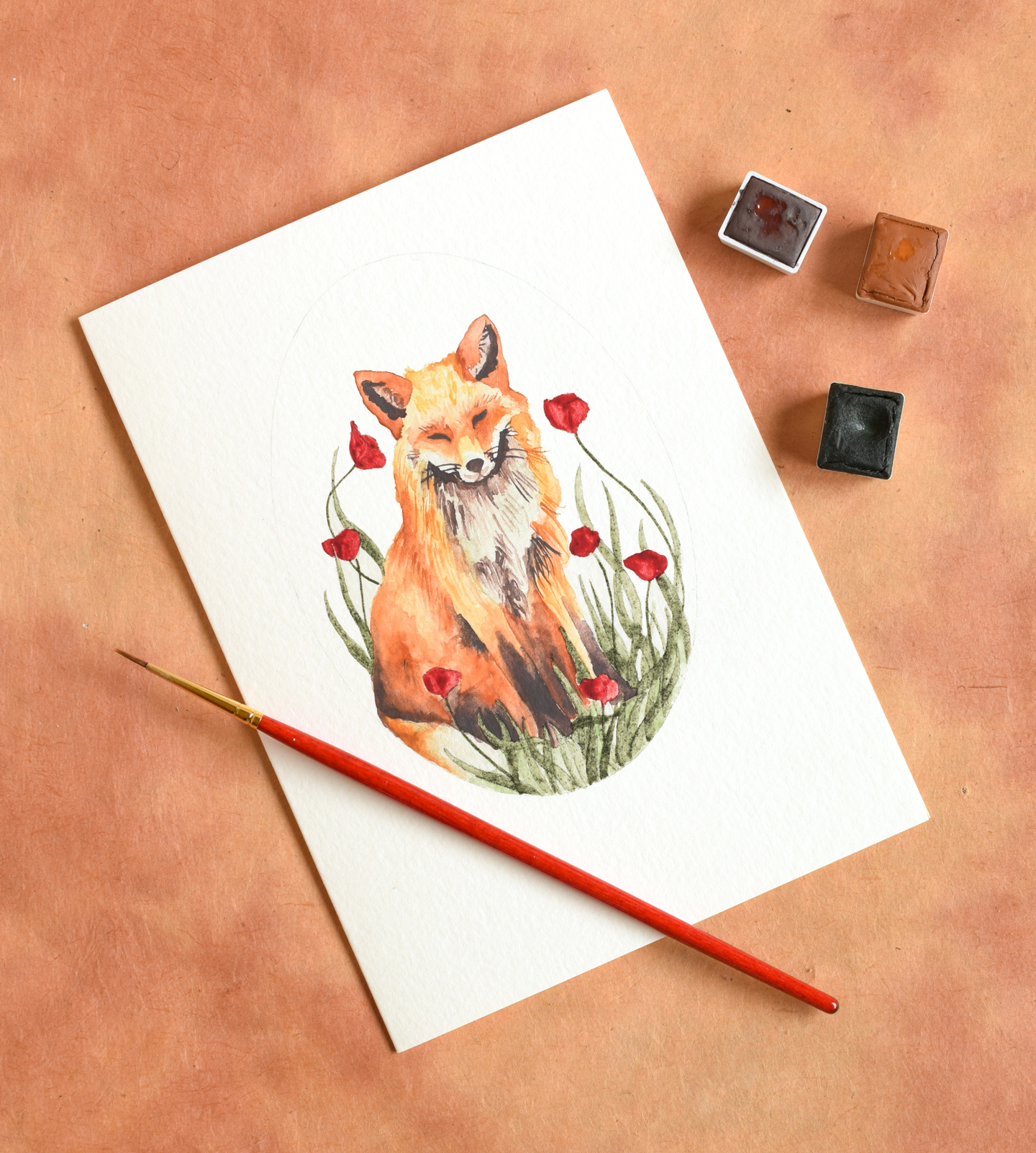
Finish off the piece by drawing a very simple Finetec border around the fox, and writing a message below the watercolor graphic. I used Janet Style calligraphy and walnut ink to write “Thank You!”.
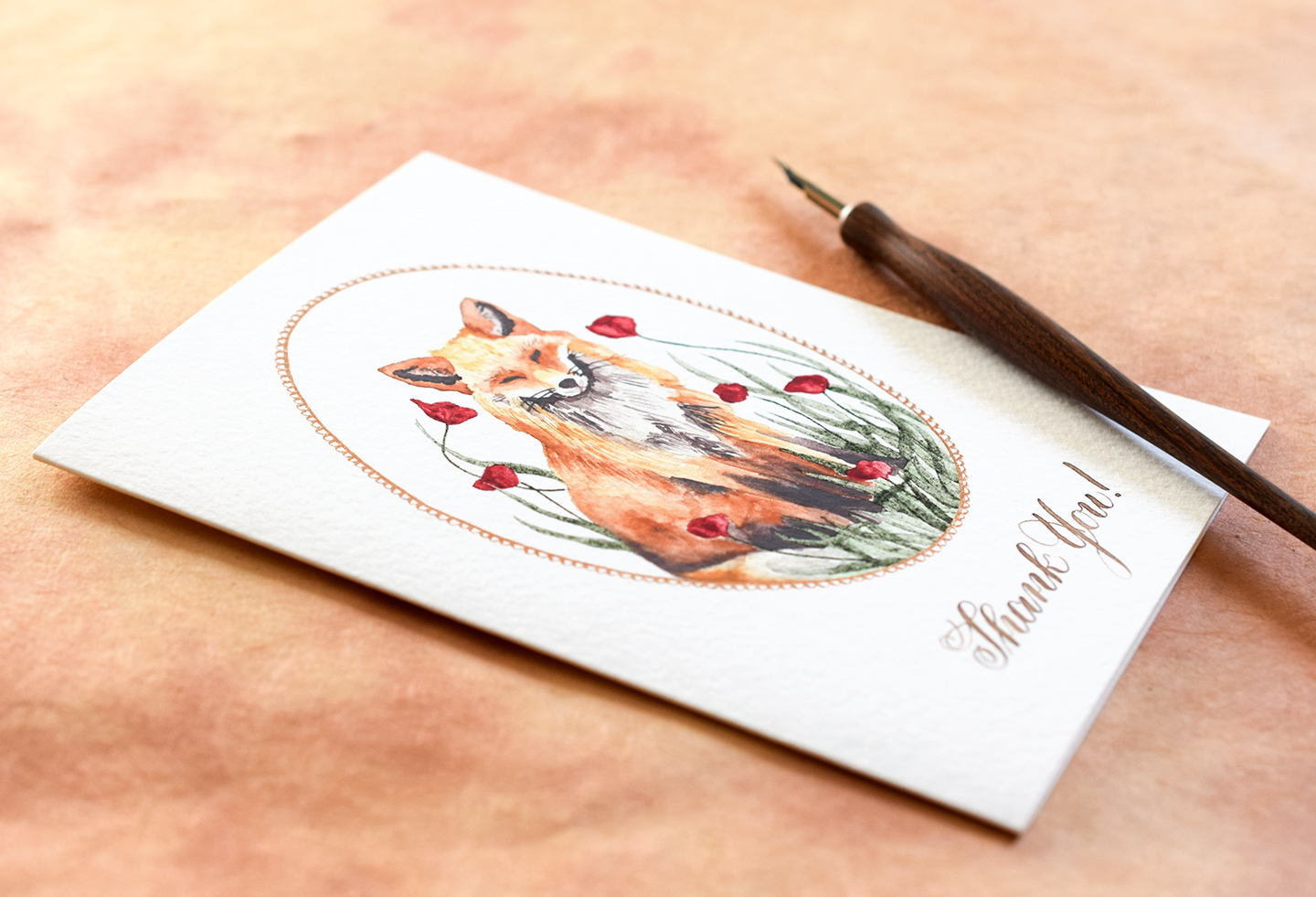
The last thing I want to do is make you feel like you should be able to go into super-artist mode and “just whip up” a realistic painting of a fox on a whim. My goal is to inspire you, not stress you out! So, if you know that making something exactly like this would prove to be frustrating, try switching up the concept! For example, instead of painting a fox, you could paint a cluster of watercolor flowers. And, of course, you don’t have to relegate yourself to watercolors; you can use any media you like and feel comfortable with!
I hope that you enjoyed this little collection of projects, and that at least one of them inspires you to create something new this weekend! If you have any questions about mail art in general, the How to Make Deliverable Mail Art post is a fantastic resource. And, of course, if you would like to see mini-tutorials like these on a regular basis, you can “like” TPK on Facebook. I’d be glad to see you there! 🙂
Thanks very much for reading, and have a good weekend!
Warmly,

*This post contains affiliate links to Amazon

























